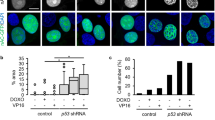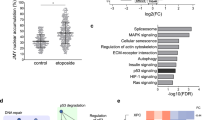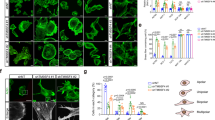Abstract
We previously reported that actin damage by treatment with an actin-depolymerizing agent including pectenotoxin-2 induces Bim-mediated apoptosis in p53-deficient human tumors. In this study, we investigated a molecular mechanism underlying Bim-mediated apoptosis of p53-deficient tumor cells following actin damage. We found that actin inhibitors increased the protein levels of p53 and p21 and thereby inactivated both Cdk2 and Cdc2 kinases. However, p53- or p21-knockout cells fail to induce p21 and hence kept both Cdk2 and Cdc2 kinases active even after treatment with actin inhibitor. The p53- or p21-knockout cells became multinucleate and polyploidy in association with induction of apoptosis. Expression of Bcl-xL resulted in accumulation of polyploid cells in association with inhibition of apoptosis. However, expression of a dominant negative mutant (Cdk2dn) and treatment with chemical inhibitors for Cdk2 suppressed not only accumulation of multinucleated cells, but also induction of Bim expression and apoptosis. Therefore, these results suggest that Bim-mediated apoptosis following actin damage due to deregulation of Cdk2 and the cell cycle by the absence of functional p53.
This is a preview of subscription content, access via your institution
Access options
Subscribe to this journal
Receive 50 print issues and online access
$259.00 per year
only $5.18 per issue
Buy this article
- Purchase on Springer Link
- Instant access to full article PDF
Prices may be subject to local taxes which are calculated during checkout







Similar content being viewed by others
References
Amon A . (1999). The spindle checkpoint. Curr Opin Genet Dev 9: 69–75.
Andreassen PR, Lohez OD, Lacroix FB, Margolis RL . (2001). Tetraploid state induces p53-dependent arrest of nontransformed mammalian cells in G1. Mol Biol Cell 12: 1315–1328.
Antignani A, Youle RJ . (2006). How do Bax and Bak lead to permeabilization of the outer mitochondrial membrane? Curr Opin Cell Biol 18: 685–689.
Barreyro FJ, Kobayashi S, Bronk SF, Werneburg NW, Malhi H, Gores GJ . (2007). Transcriptional regulation of Bim by FoxO3A mediates hepatocyte lipoapoptosis. J Biol Chem 282: 27141–27154.
Bunz F, Dutriaux A, Lengauer C, Waldman T, Zhou S, Brown JP et al. (1998). Requirement for p53 and p21 to sustain G2 arrest after DNA damage. Science 282: 1497–1501.
Castedo M, Coquelle A, Vivet S, Vitale I, Kauffmann A, Dessen P et al. (2006). Apoptosis regulation in tetraploid cancer cells. EMBO J 25: 2584–2595.
Chae HD, Choi TS, Kim BM, Jung JH, Bang YJ, Shin DY . (2005). Oocyte-based screening of cytokinesis inhibitors and identification of pectenotoxin-2 that induces Bim/Bax-mediated apoptosis in p53-deficient tumors. Oncogene 24: 4813–4819.
Chae HD, Yun J, Bang YJ, Shin DY . (2004). Cdk2-dependent phosphorylation of the NF-Y transcription factor is essential for the expression of the cell cycle-regulatory genes and cell cycle G1/S and G2/M transitions. Oncogene 23: 4084–4088.
Di Leonardo A, Khan S, Linke S, Greco V, Seidita G, Wahl G . (1997). DNA rereplication in the presence of mitotic spindle inhibitors in human and mouse fibroblasts lacking either p53 or pRb function. Cancer Res 57: 1013–1019.
Gilley J, Coffer PJ, Ham J . (2003). FOXO transcription factors directly activate bim gene expression and promote apoptosis in sympathetic neurons. J Cell Biol 162: 613–622.
Graham FL, van der Eb AJ . (1973). Transformation of rat cells by DNA of human adenovirus 5. Virology 54: 536–539.
Hartwell LH, Weinert TA . (1989). Checkpoints: controls that ensure the order of cell cycle events. Science 246: 629–634.
Hollstein M, Sidransky D, Vogelstein B, Harris CC . (1991). p53 mutations in human cancers. Science 253: 49–53.
Jordan M, Thrower D, Wilson L . (1991). Mechanism of inhibition of cell proliferation by Vinca alkaloids. Cancer Res 51: 2212–2222.
Jordan M, Wendell K, Gardiner S, Derry W, Copp H, Wilson L . (1996). Mitotic block induced in HeLa cells by low concentrations of paclitaxel (Taxol) results in abnormal mitotic exit and apoptotic cell death. Cancer Res 56: 816–825.
Jung MS, Yun J, Chae HD, Kim JM, Kim SC, Choi TS et al. (2001). p53 and its homologues, p63 and p73, induce a replicative senescence through inactivation of NF-Y transcription factor. Oncogene 20: 5818–5825.
Khan S, Wahl G . (1998). p53 and pRb prevent rereplication in response to microtubule inhibitors by mediating a reversible G1 arrest. Cancer Res 58: 396–401.
Kuerbitz SJ, Plunkett BS, Walsh WV, Kastan MB . (1992). Wild-type p53 is a cell cycle checkpoint determinant following irradiation. Proc Natl Acad Sci USA 89: 7491–7495.
Lanni JS, Jacks T . (1998). Characterization of the p53-dependent postmitotic checkpoint following spindle disruption. Mol Cell Biol 18: 1055–1064.
Minn AJ, Boise LH, Thompson CB . (1996). Expression of Bcl-xL and loss of p53 can cooperate to overcome a cell cycle checkpoint induced by mitotic spindle damage. Genes Dev 10: 2621–2631.
Puthalakath H, O'Reilly LA, Gunn P, Lee L, Kelly PN, Huntington ND et al. (2007). ER stress triggers apoptosis by activating BH3-only protein bim. Cell 129: 1337–1349.
Rudner AD, Murray AW . (1996). The spindle assembly checkpoint. Curr Opin Cell Biol 8: 773–780.
Sedlak TW, Oltvai ZN, Yang E, Wang K, Boise LH, Thompson CB et al. (1995). Multiple Bcl-2 family members demonstrate selective dimerizations with Bax. Proc Natl Acad Sci USA 92: 7834–7838.
Stahl M, Dijkers PF, Kops GJ, Lens SM, Coffer PJ, Burgering BM et al. (2002). The forkhead transcription factor FoxO regulates transcription of p27Kip1 and Bim in response to IL-2. J Immunol 168: 5024–5031.
Torres K, Horwitz S . (1998). Mechanisms of taxol-induced cell death are concentration dependent. Cancer Res 58: 3620–3626.
Yun J, Chae HD, Choi TS, Kim EH, Bang YJ, Chung J et al. (2003). Cdk2-dependent phosphorylation of the NF-Y transcription factor and its involvement in the p53-p21 signaling pathway. J Biol Chem 278: 36966–36972.
Acknowledgements
pCMV-Cdk2D145N (Cdk2dn) was given from Dr van den Heuvel (MGH cancer center, MA, USA). This research was supported by Korea Science & Engineering Foundation through the NRL Program, the Aging-Tumorigenesis Research program, and the New Drug target discovery Program, and by Korean Ministry of Health and Welfare through the Cancer Control Program and the Molecular Aging Research Center.
Author information
Authors and Affiliations
Corresponding author
Rights and permissions
About this article
Cite this article
Chae, H., Kim, B., Yun, U. et al. Deregulation of Cdk2 causes Bim-mediated apoptosis in p53-deficient tumors following actin damage. Oncogene 27, 4115–4121 (2008). https://doi.org/10.1038/onc.2008.46
Received:
Revised:
Accepted:
Published:
Issue Date:
DOI: https://doi.org/10.1038/onc.2008.46
Keywords
This article is cited by
-
Cell cycle dependence of apoptosis photo-triggered using peptide-photosensitizer conjugate
Scientific Reports (2020)
-
Di(2-ethylhexyl) phthalate inhibits glutathione regeneration and dehydrogenases of the pentose phosphate pathway on human colon carcinoma cells
Cell Stress and Chaperones (2020)
-
Diazinon, an organophosphate pesticide, induces oxidative stress and genotoxicity in cells deriving from large intestine
Environmental Science and Pollution Research (2016)



